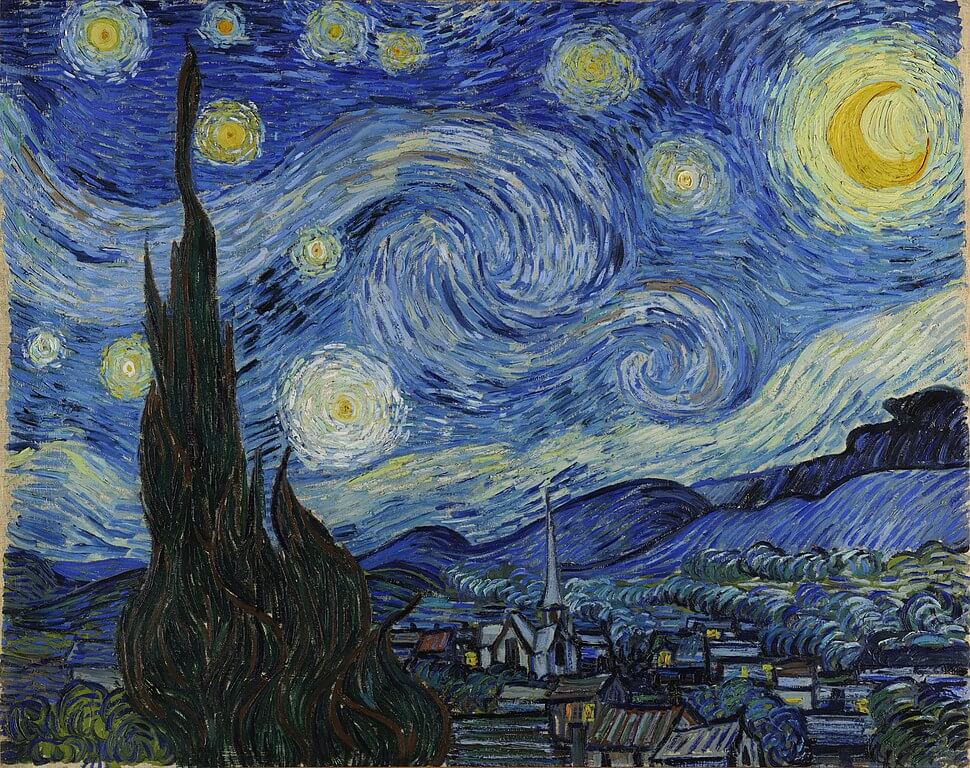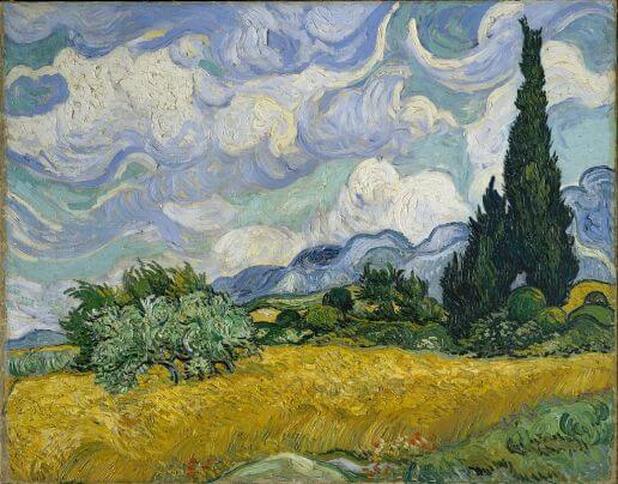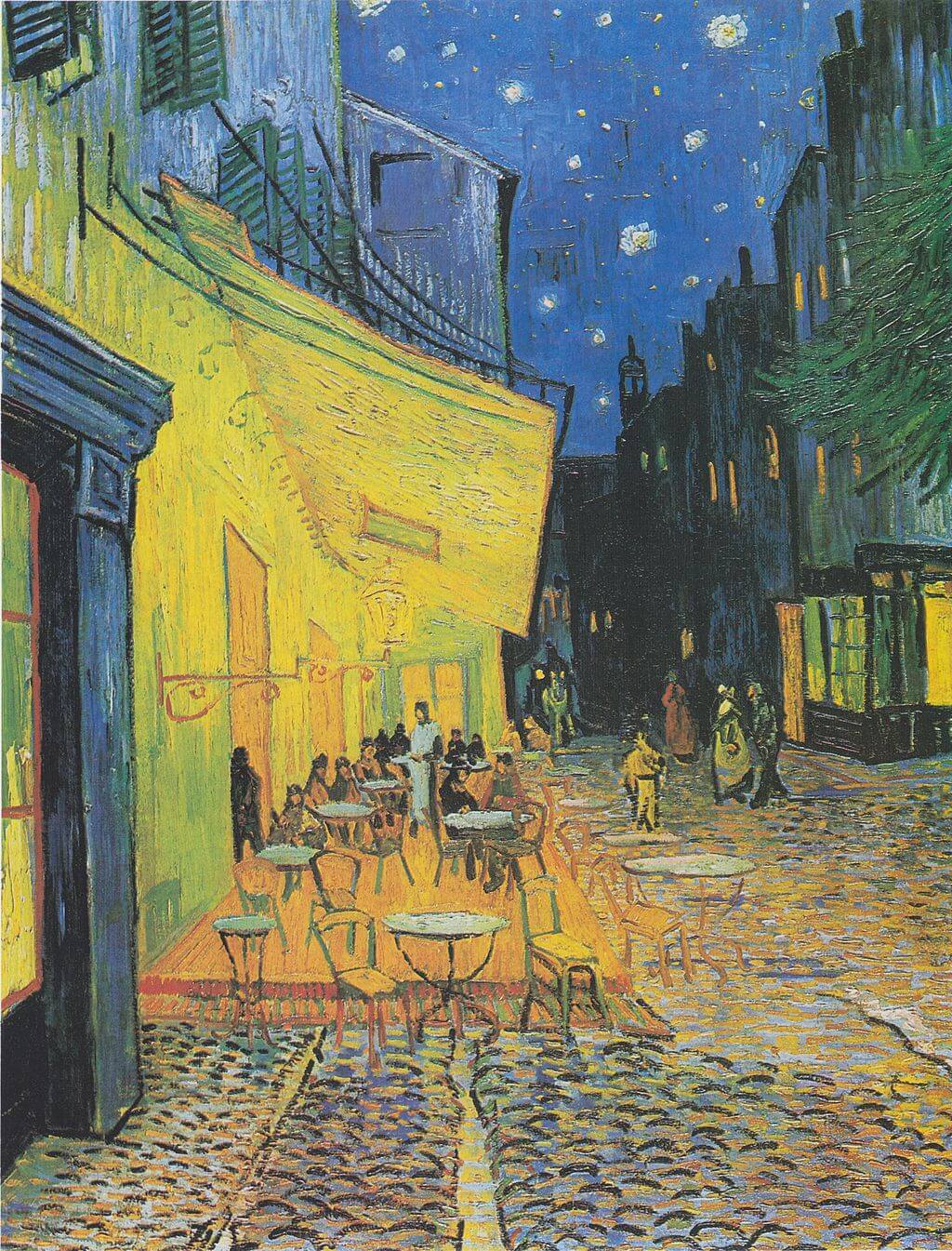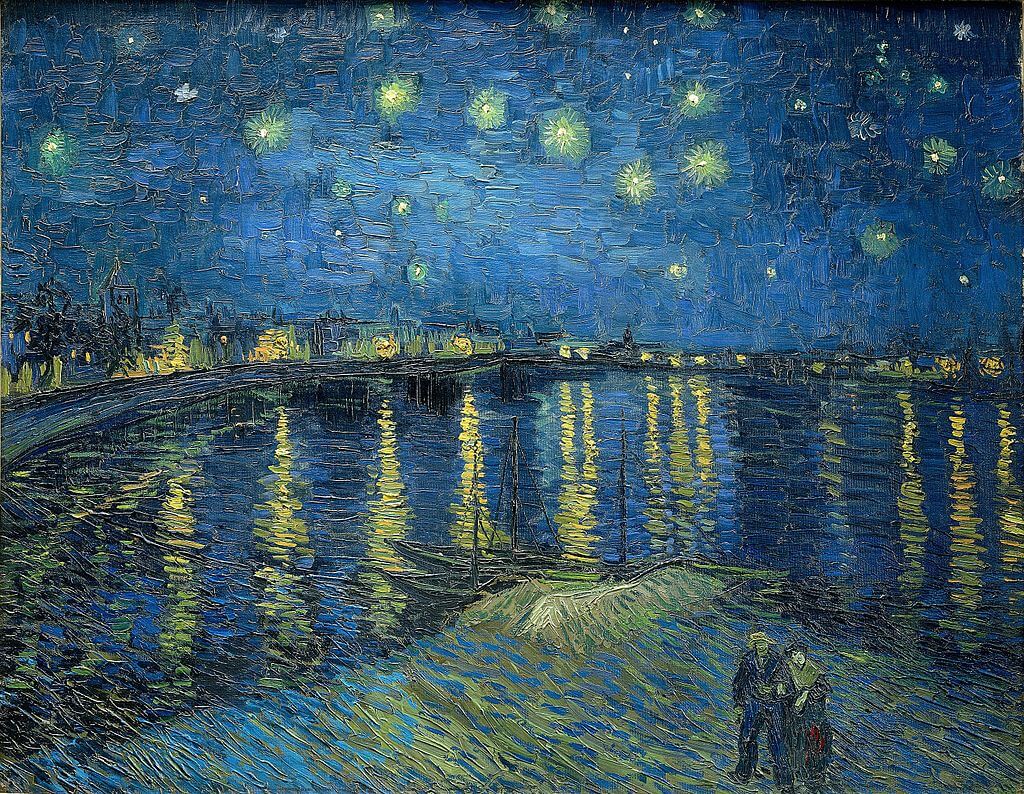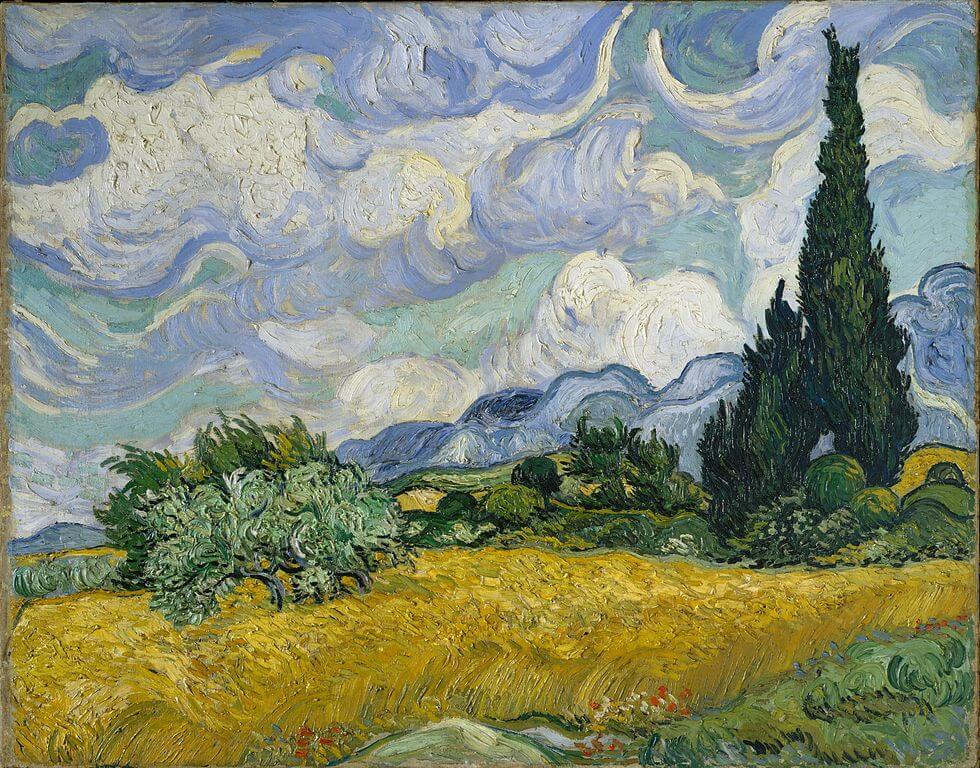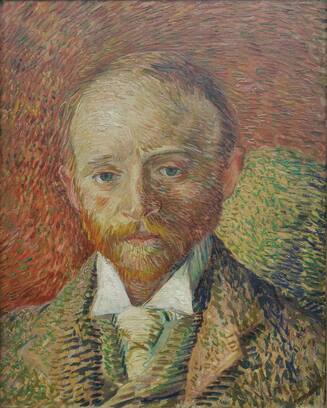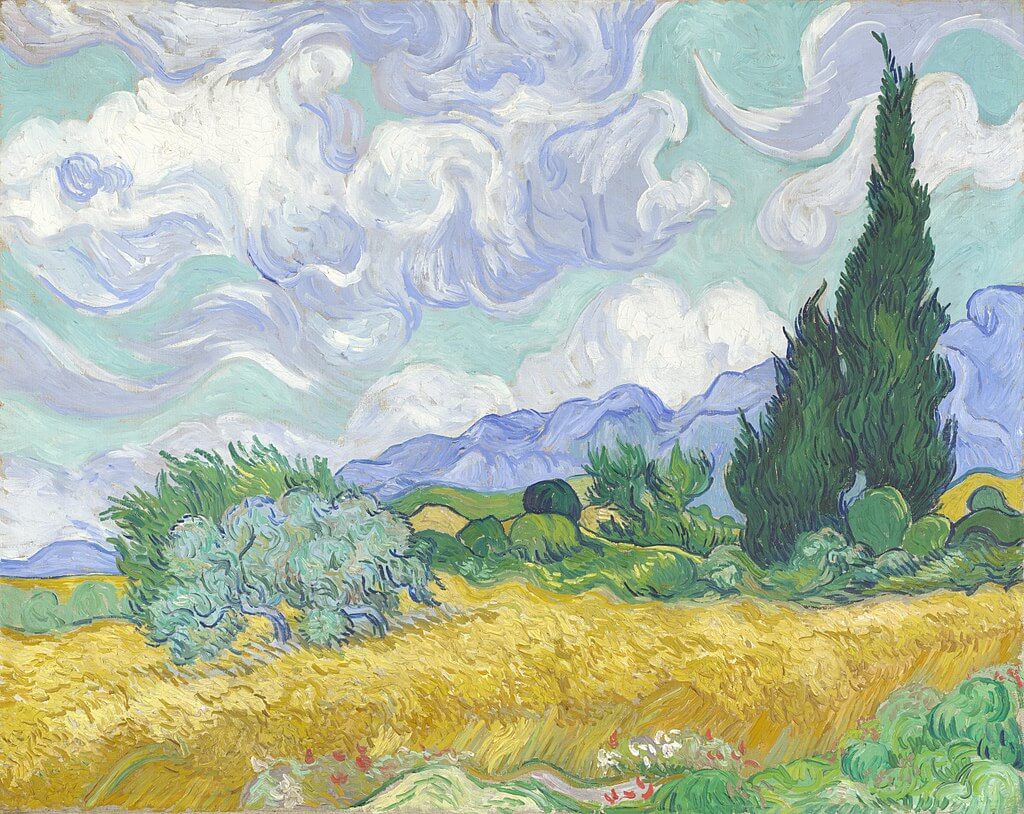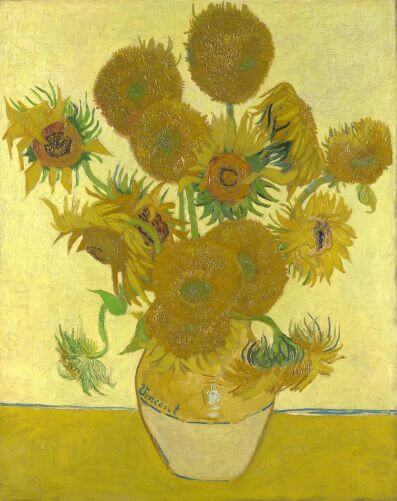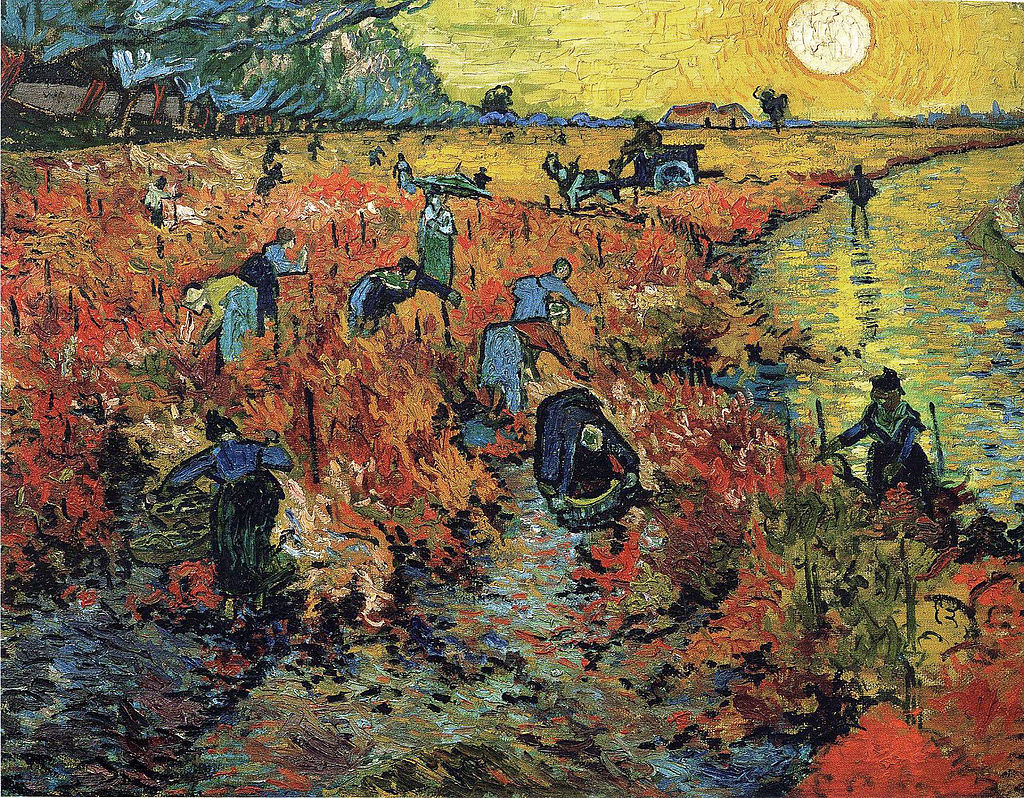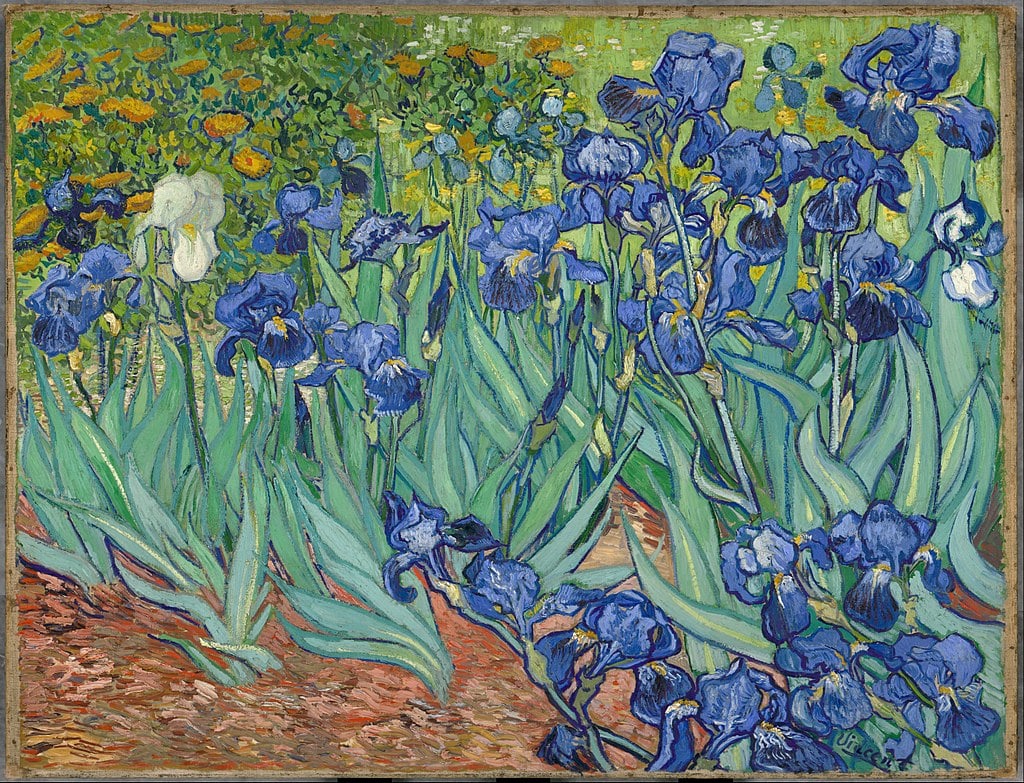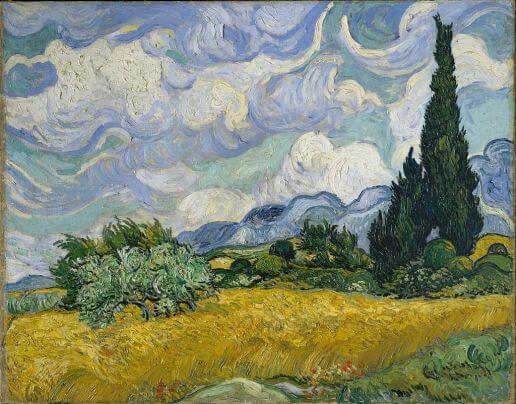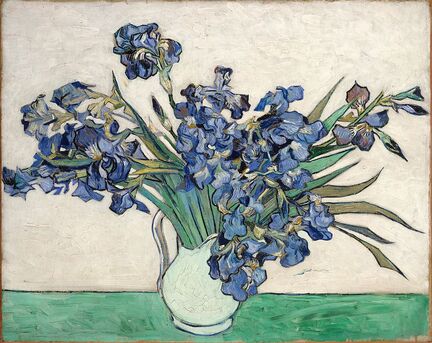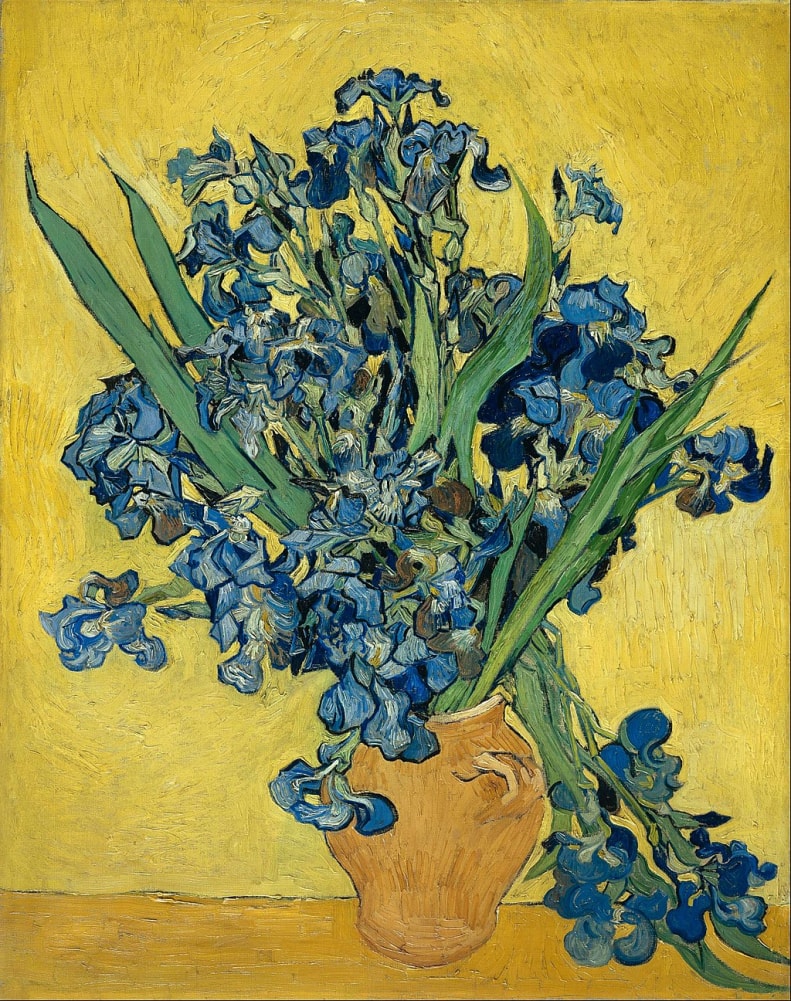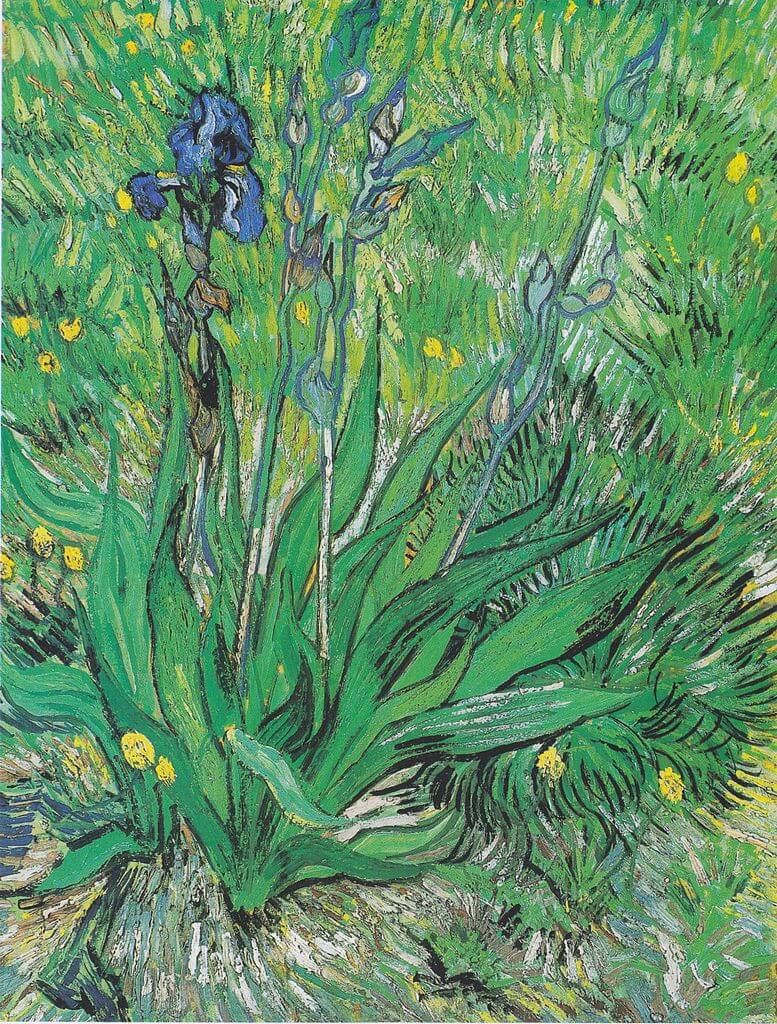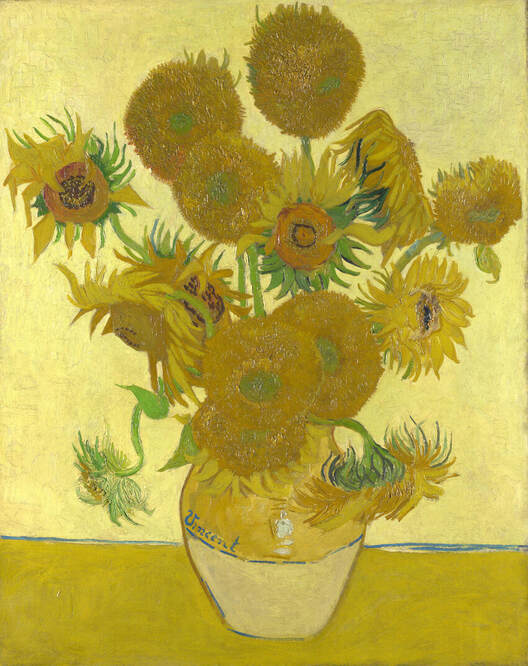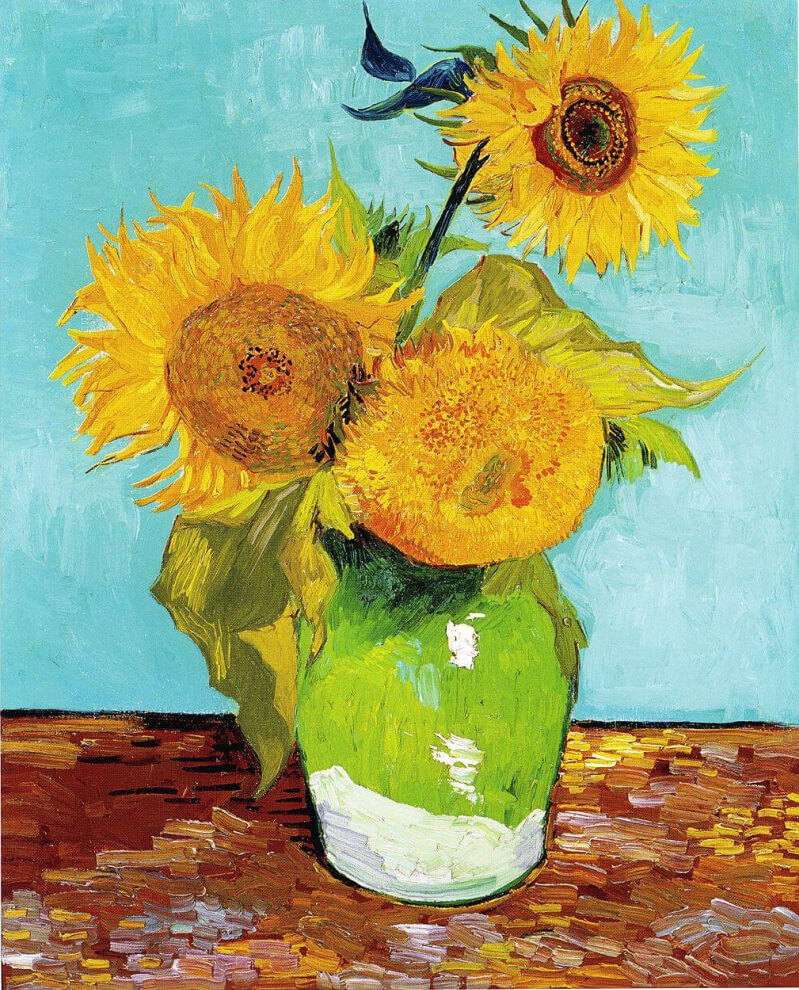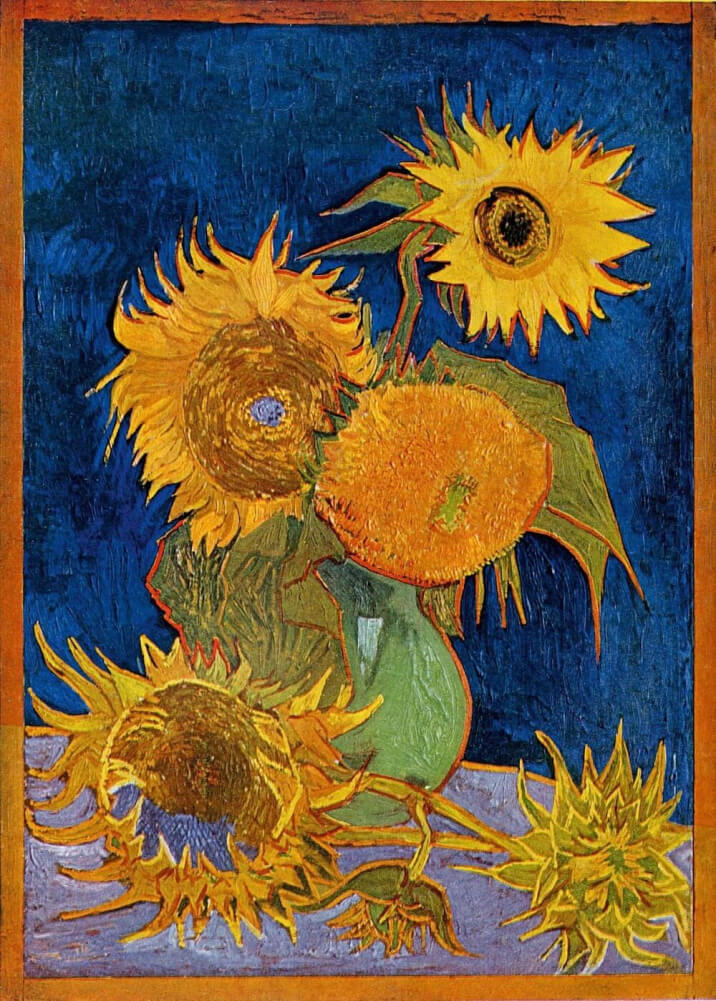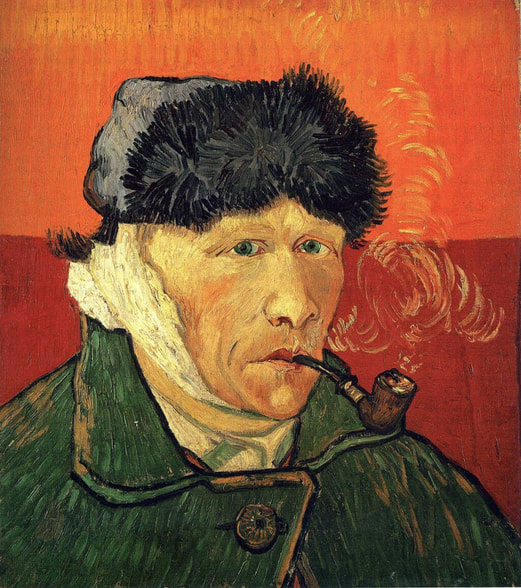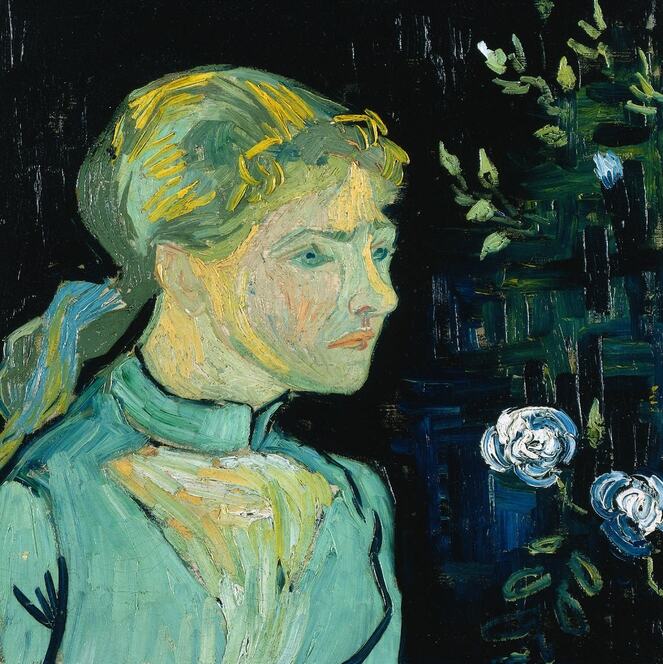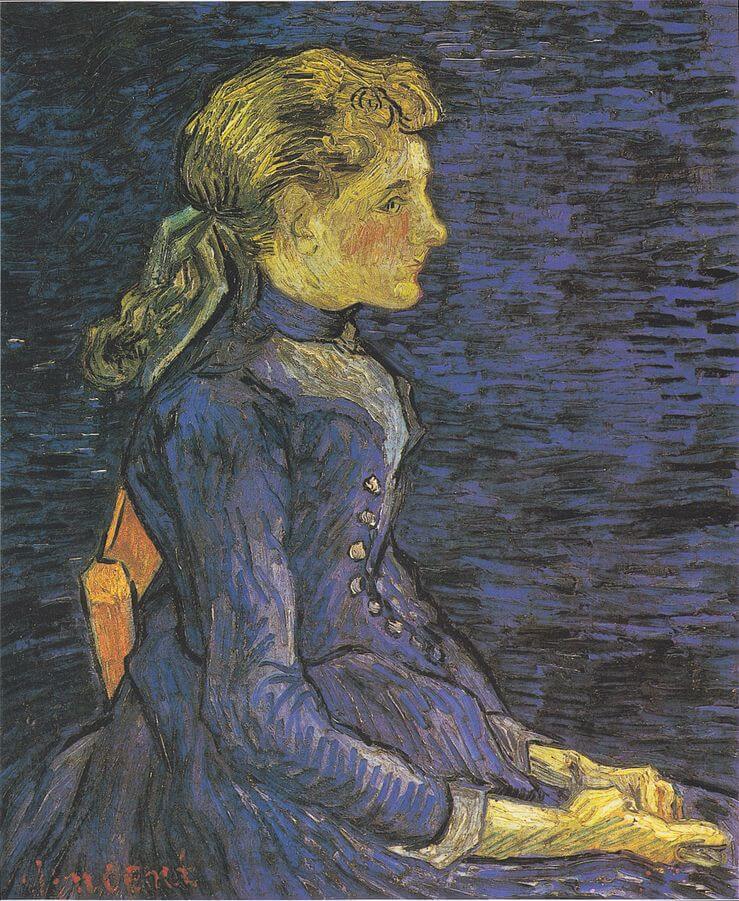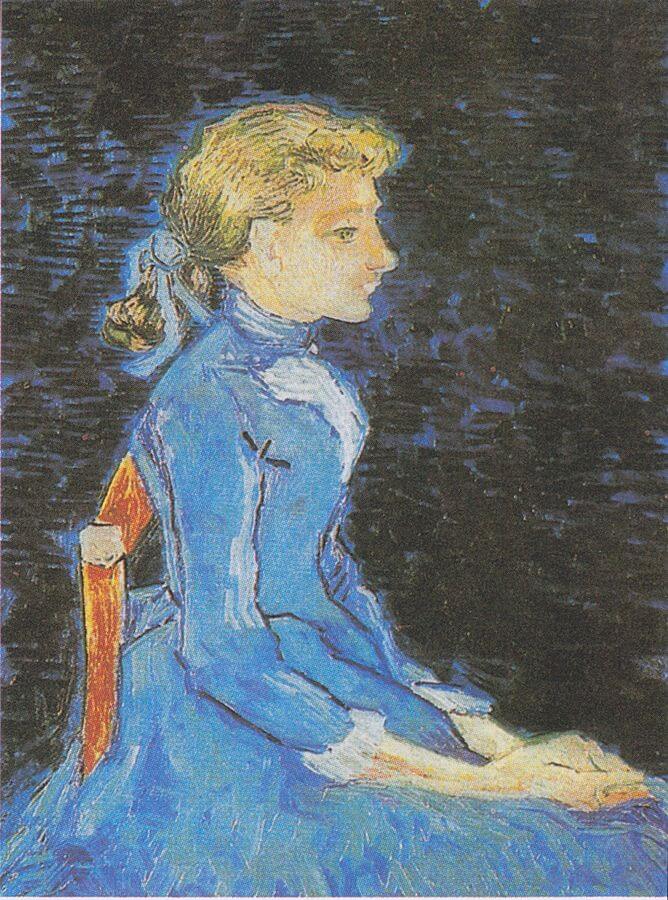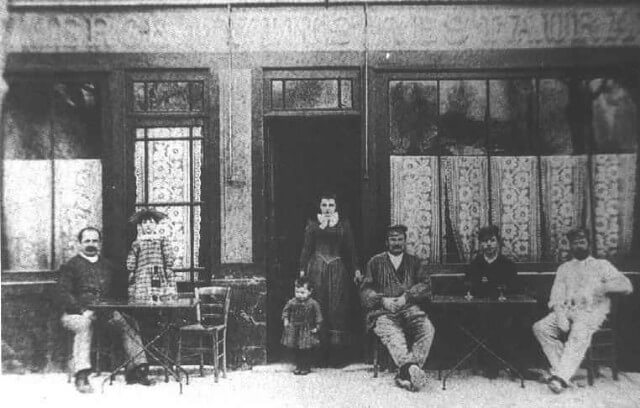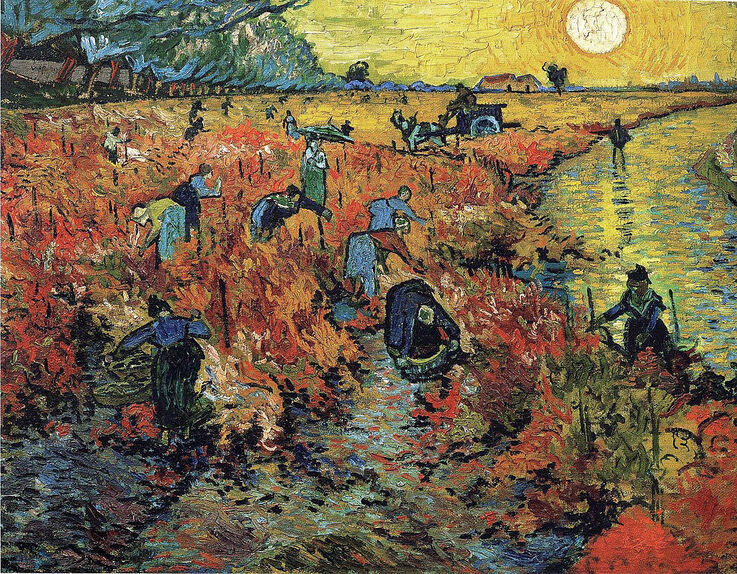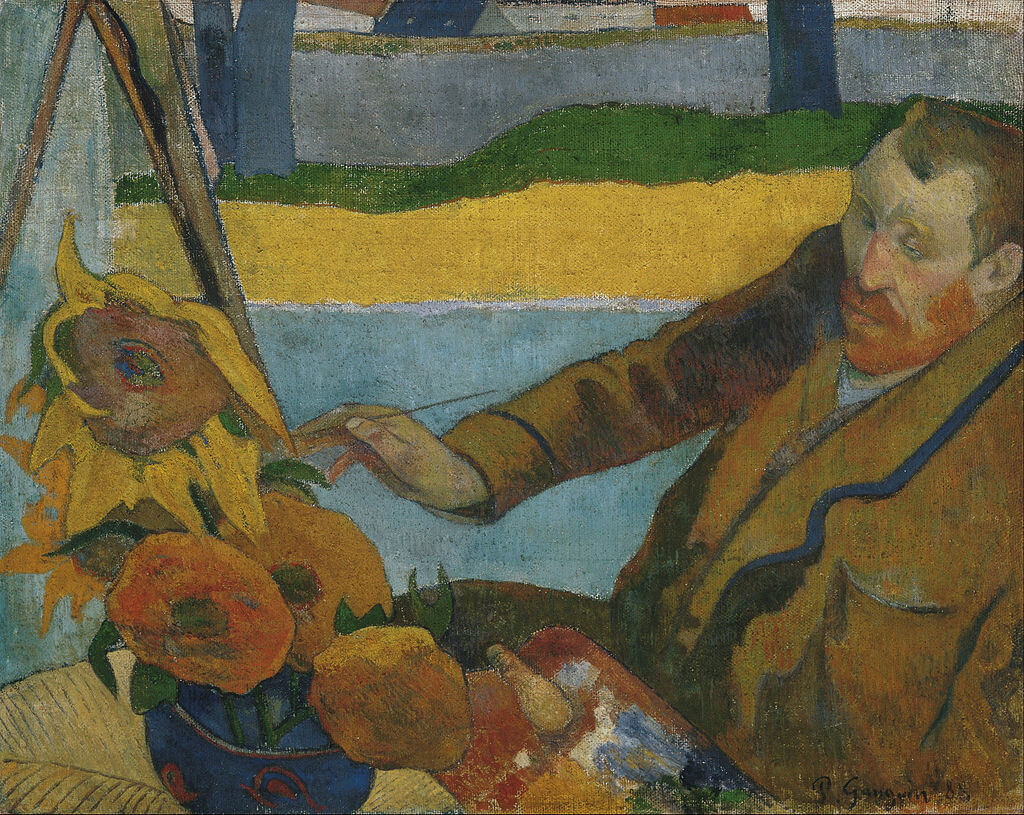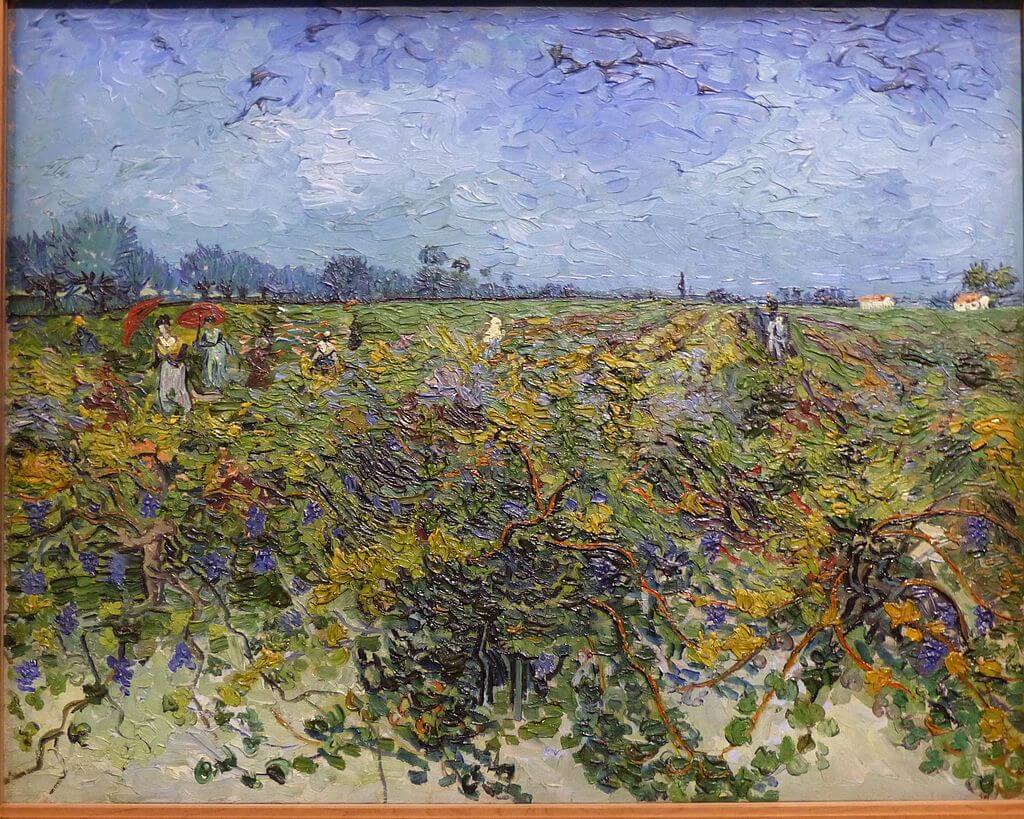|
Where? Floor 5, Gallery 1 of the Museum of Modern Art
When? June 1889 What do you see? This painting is an imaginative version of a starry night in Saint-Rémy in France where Van Gogh was staying at that time. The various elements in this painting are certainly inspired by what Van Gogh observed in reality, but he created his own ideal version of the starry night. In the painting, we can observe some trees, a village, and mountains under a night sky full of stars (or more precisely a collection of 12 celestial bodies). In the foreground, you can observe a big wavy cypress tree. The cypress is an element that comes back in multiple Van Gogh paintings, such as the Wheat Field with Cypresses in the Metropolitan Museum of Art. On the top right is a crescent moon. The brightest celestial body in the painting, just to the right of the cypress tree, is the planet Venus. The celestial bodies light up the sky (indicated by the use of white paint in the night sky). The church tower in the middle foreground is probably the Saint-Martin church in Saint-Rémy. Van Gogh, however, did not include the dome of the church in this painting. In the village surrounding the church, several houses still have their lights on. On the right side of the painting, between the village and the mountains, you can see a forest. The curvy lines used for the cypress tree and the clouds in the sky create a sense of movement in this painting. Notice also the clear contrast between the turbulent sky and the quiet life on earth. The cypress in the form of a big fire is the only element that connects the earth and sky with each other.
Backstory: The painting is created between June 16 and 18, 1889 when Van Gogh was staying in the hospital of Saint-Paul-de-Mausole at Saint-Rémy. In a letter to his brother Theo, he wrote: “This morning I saw the countryside from my window a long time before sunrise, with nothing but the morning star, which looked very big.” He mixed this view both with some other elements that he observed in the area of Saint-Rémy and his imagination to create this painting.
Van Gogh used thick broad strokes of oil paint to create this painting and it was probably created in a single day (even though the idea for this painting was already occupying his mind for over a year). If you look carefully, you can still see some pieces of the canvas in between the broad strokes of paint. Symbolism: There is some debate on whether this painting should be interpreted symbolically. One symbolic explanation for this painting centers around the cypress which connects the earth to the sky in this painting. The cypress tree is associated with cemeteries and death. In this painting, it could be the connection between life (which happens on earth) and death (which is when you go to the stars according to Van Gogh). Van Gogh wrote in one of his letters “We take death to go to a star.” Van Gogh, who would eventually commit suicide, was interested in death and he expressed some ideas that one would go to the stars after death. Other versions of the Starry Night? Van Gogh was already interested in the idea of painting a starry night in 1888 as expressed in several letters to his friends and brother. Indeed, in 1888 he painted two versions of a starry night. The first version is Café Terrace at Night which is in the Kröller-Müller Museum in The Netherlands. The second version is Starry Night over the Rhône which is in the Musée d’Orsay in Paris. However, these two paintings did not fulfill his idea of a perfect starry night. Instead of a starry night above a town, he was more interested in a starry night above a landscape and a more imaginative version of the night sky.
Who is Van Gogh? Vincent van Gogh (1853-1890) was born in Zundert in The Netherlands. At the end of his life, he created many paintings that fall under the Post-Impressionist style. Van Gogh has produced a large number of paintings during his life and most of them have been painted in the last two years of his life.
Vincent van Gogh wrote many letters during his life -- many of which to his brother Theo -- which have been saved. In these letters, he explained his ideas about painting and they form a valuable source to interpret his works. The work of Van Gogh was not really appreciated during his life, but his work has become famous after his suicide in 1890. Fun fact: While this is nowadays considered to be one of the best paintings by Vincent van Gogh, he did not seem very proud of this painting. When he wrote a letter to his brother Theo after he left Saint-Rémy, he did not mention this painting as a good one. In fact, he listed several paintings, including the Wheatfield with Cypresses, as “a little good.” About the other paintings from that period, including this painting, he writes “the rest says nothing to me.” His brother Theo seemed to agree that The Starry Night is not his best work. He was worried about the more imaginary nature of this work compared to the somewhat more realistic paintings he created before. He advised Vincent to stick to still lifes and flowers as that would have more therapeutic value for the mentally troubled Vincent.
4 Comments
The painting shows a large ripe gold-colored wheat field which is ready for harvest. On the right are two darker cypresses that draw the attention. To the left are lighter and smaller cypresses. The whirling clouds and blue mountains in the background complete this landscape. You can almost feel the wind that is affecting the clouds and the wheat field. This movement is emphasized by the impasto technique used for this painting, in which the paint is applied in thick layers.
Backstory: Van Gogh painted this wheat field (by some referred to as a cornfield) with cypresses when he was in a mental asylum in Saint Remy in the south of France. He painted this when he was allowed to make short walks and paint outside of the asylum. He was particularly impressed by the cypresses he saw there as he felt that this tree reflected some of his emotions. Van Gogh liked this painting so much that he repeated this painting three more times. One version is in the National Gallery in London (and was acquired in 1923 for ₤300, which was similar to the price of a house at that time). Another (smaller) version is part of a private collection. The last version (a pen drawing) is in the Van Gogh Museum in Amsterdam.
Symbolism: Van Gogh used his paintings to express his ideas of the meaning of life. The wheat fields represent the cycle of life, where people celebrate their growth, but at the same time are susceptible to the powerful forces of nature. The cypresses are a symbol of stability in a wild landscape (though at the same time the cypress was associated with cemeteries and death in the south of France, though many believe that this was not the intended meaning of the cypresses for Van Gogh).
Who is Vincent van Gogh? Vincent van Gogh (1853 – 1890) was born in The Netherlands. His work is classified as Post-Impressionism and includes landscapes, portraits, self-portraits, and still lifes. Well-known are his depictions of cypresses, sunflowers, and wheat fields. In 1886, Van Gogh moved to Paris, where he connected with the French Impressionists, such as Paul Gauguin and Claude Monet. In 1888, Van Gogh moved further south in France to Arles where he painted his famous series of sunflower paintings, including the version that is in the National Gallery in London. A year later he moved to a nearby mental asylum in Saint Remy, due to his poor mental state, but continued to produce his paintings. During this time, he produced not only this painting but also The Starry Night which is in the Modern Museum of Art in New York. Van Gogh was a heavy drinker and smoker, and his mental state is often reflected in his paintings. In 1890, Van Gogh died at 37 years old from a self-inflicted gunshot wound.
What is post-impressionism? Post-Impressionism is a French art movement which developed in response to Impressionism. It is an extension of Impressionism, which is characterized by paintings with bright colors, real-life subject matters, and a thick application of paint.
Post-impressionism extended on Impressionism by adding emotions and symbolism to the paintings to reflect the artist’s state of mind. Besides Van Gogh, well-known painters in this movement include Paul Gauguin, Georges Seurat, and Paul Cézanne. Fun fact: On the list of the 100 most expensive paintings ever sold, Pablo Picasso, Andy Warhol, and Vincent van Gogh are best represented. Van Gogh has most paintings on this list (at least seven). For example, Wheat Field with Cypresses was bought in 1993 for $57 million and donated to the Metropolitan Museum of Art. But unlike Picasso and Warhol, Van Gogh did not get rich during his life. In fact, the only known painting that Van Gogh sold during his life, The Red Vineyard, was sold for 400 Belgian Francs, which is worth about $1,500 nowadays. Interested in a copy for yourself? Poster or canvas (Amazon links)
Where? Room W204 of the Getty Museum
When? 1889 What do you see? In the foreground are blooming blue irises with green stems and leaves with pointy tips. One the left is a single white iris with large petals. In the background are orange marigolds. The flowers are planted in the red-brown earth. On the top right is a meadow lit up by the Mediterranean sunlight. Van Gogh used bright blue and violet colors for the irises and this color contrast nicely with the other colors in this painting. The contrast makes the flowers stand out and makes the flowers come alive. Van Gogh also used the contrast in texture, and you can see that the different elements in this painting have their unique look and texture. For example, the earth in the foreground has a rough texture which contrasts nicely with the smooth texture of the stems and leaves of the irises. The somewhat disorganized petals of the irises also contrast with these smooth leaves and stems. The marigolds in the background have again a different texture. Van Gogh was probably sitting on the ground while painting these irises, which emphasizes the presence of the green stems and leaves. Backstory: Van Gogh painted this work several days after he was admitted to the mental asylum in Saint-Rémy-de-Provence, France. In his first letter from the asylum to his brother Theo, Vincent wrote that he was focusing on painting irises and lilies. These colorful flowers may have provided him with feelings of hope that may have helped him temporarily with his mental state. However, one year after he was admitted to the asylum, he died because of a self-inflicted gun wound. Van Gogh's death was the result of a troubled life, though not everybody could understand that. Monet commented on the death of Van Gogh that he could not understand how a man that loved flowers so much and could depict them in such a beautiful way could be unhappy with his life. What are irises? There are almost 300 different types of irises. The iris exists in many different colors, explaining its name which is derived from the Greek word for rainbow. The most common color for irises is violet-blue, which is the color of the irises depicted in Van Gogh’s painting. The iris can grow from a root or a bulb. Irises have a long stem and one or more six-lobed petals. For bearded irises, the type depicted in this painting, three of these petals curve up and the other three bend down. These irises grow up to about 120 centimeters. Why irises? The simplest explanation is that irises where blooming in the garden of the asylum to which Van Gogh was admitted. Van Gogh was not allowed to leave the asylum and its garden in the first month, so the availability of the blooming irises was a good reason to paint them. Another reason that he painted irises was that Van Gogh loved flowers and flower paintings. Flowers are colorful, and they allowed Van Gogh to experiment with different colors. Van Gogh liked to play around with different colors to provide contrasting effects and to make certain elements in his painting stand out more. His use of colors was inspired by Eugène Delacroix, who he called ‘the greatest colorist of all.' A third reason is that flowers were a popular subject among the masses and Van Gogh hoped throughout his career for some commercial success (which he never got during his life). Who is Van Gogh? Vincent Willem van Gogh was born in 1853 in Zundert, The Netherlands. He only started to fully focus on painting in 1883. In 1886 he moved to Paris, and, two years later he moved to the south of France, to Arles. He struggled with mental illness and died in 1890 from the results of a self-inflicted gunshot wound. Most of Van Gogh’s famous paintings come from the last three years of his life. Examples include his famous series of sunflowers, of which one version is in the National Gallery in London. Another example is his Wheat Field with Cypresses in the Metropolitan Museum of Art (he made two other versions of that painting, one in the National Gallery and another in a private collection). His later work can be characterized by broad brush strokes, the unique combination of colors, and the use of innovative perspectives and designs.
Fun fact: Irises was sold in 1987 for a record-breaking fee of $53.9 million to the Australian businessman Alan Bond. However, he failed to repay a substantial loan he got from the auction house, and the painting was resold in 1990 to the Getty Museum.
Van Gogh created more paintings with irises as the main subject. In the Metropolitan Museum of Art hangs the painting Irises and the Van Gogh Museum in Amsterdam has another version of a vase with irises. The National Gallery of Canada exhibits Iris, a painting with a single iris.
Where? Room 43 of the National Gallery
When? 1888 What do you see? A total of 15 sunflowers is depicted. The sunflowers are actually dying, and you can see that almost half of the sunflowers does not have any petals left. Specifically, six sunflowers only have their flower head left, and the sunflower on the top right only has a single petal on it. This is an indication that they are at the end of their life. The sunflowers that we often adore are the ones with the petals still on it, and in combination with the flower head, they make the sunflower look like a sun with rays. The petals of the sunflowers that still have them are quite spiky. Notice also the colors that Van Gogh used. Besides some green, he used different shades of yellow. It is very difficult to create a painting with a clear subject and interpretation with such a limited array of colors, yet Van Gogh succeeded in creating a painting of sunflowers that can be recognized from a large distance. This still-life painting beams of the wall and energizes people around the world, something that is very uncommon for still-lifes which are often considered to be somewhat dull. Backstory: A painting of sunflowers is immediately associated with Van Gogh. He created a total of 11 paintings of sunflowers. The first series of four paintings shows sunflowers lying on the ground and the second series of seven paintings shows sunflowers in a vase. This second series contains four originals which he created in a single week. Van Gogh also made three copies of the paintings in the second series. Two of these three copies are copied from the Sunflowers version in the National Gallery. One of these copies is currently in the Van Gogh Museum in Amsterdam, and the other copy is in the Seiji Togo Memorial Sompo Japan Museum of Art in Tokyo (this version was sold for almost $40 million in 1987, making it the most expensive painting ever sold at that time). Sunflowers for Paul Gauguin: Van Gogh’s idea was to create these sunflower paintings as a decoration for the room of Paul Gauguin who would join him in Arles to paint. He knew that Gauguin liked sunflowers as, in the year before, Gauguin had exchanged one of his paintings for two of the earlier sunflower paintings of Van Gogh. Van Gogh was very excited that Gauguin would visit him and was in a fantastic mood when he created his second series of sunflower paintings. When Gauguin arrived, he was indeed impressed by these paintings and even Van Gogh himself was quite happy with the results (which was uncommon for him). The interest of Van Gogh in flowers was probably stimulated by his nationality as flowers are a very big part of the culture in The Netherlands. In fact, The Netherlands is the biggest flower exporting country in the world.
Symbolism: These sunflowers also have a symbolic value (though it is not clear how important this symbolic value was to Van Gogh). Flowers are a symbol of life. They have a period in which they bloom beautifully and they are in their prime, but eventually, they die. The cycle of a flower’s life is often used as an analogy for human life and should remind us of our own mortality. However, inside the flower head are the seeds of new life. These seeds refer to the cycle of life on this planet.
Who is Van Gogh? Vincent van Gogh (1853-1890) was born in Zundert in The Netherlands. He only started his artistic career in 1881 and so all the works we know from him are made within one decade. For many of his later paintings, Van Gogh studied a landscape, the sky, or some flowers in front of him while working on the painting. He liked to be outside while painting. His favorite color, which you can see in many of his paintings, is yellow. He considered yellow to be the color of life (as the sun is also yellow). Van Gogh developed a unique style of painting, which is very recognizable. Especially in his later years, he applied thick layers of paint to the canvas and used heavy brushstrokes. His work appeals worldwide to many people that are otherwise not so interested in art. Fun fact: Van Gogh’s idea was to create a painting community in Arles, where he moved in February 1888, but nobody wanted to join him there initially because of his difficult personality. However, the brother of Vincent convinced Paul Gauguin to join him and Vincent was very excited about this. On October 23, 1888, Gauguin joined Van Gogh in Arles. But the collaboration did not turn out well and Gauguin left in December 1888. According to Gauguin, Van Gogh threatened him with a razor and Gauguin ran away. That same night Van Gogh mutilated his own ear with a razor blade, which caused severe bleeding. He applied a bandage to his ear and packaged his ear in a piece of paper, which he brought to a woman in the brothel nearby that he frequented. He painted a self-portrait with a bandaged ear and pipe which is currently in a private collection.
Written by Eelco Kappe
Where? Gallery 222 of the Cleveland Museum of Art
When? 1890 What do you see? A portrait of Adeline Ravoux, the daughter of the innkeeper from whom Van Gogh rented a room. Adeline wears a blue dress with a high collar, a white bodice under it, and a blue ribbon in her hair. The color of the dress matches her blue eyes. While she was 12 years old when Van Gogh created this painting, she looks much older. This was actually the idea of Van Gogh, as he wanted to portray her as the woman she would become. Her expression is a bit aggressive or unhappy, which may imply that she hears about her future as a woman. On the right are two white flowers and a series of green leaves floating in the air. The white flowers may symbolize purity and innocence and may also refer to her future as a married woman. Backstory: Van Gogh created this painting one month before he committed suicide. He based this painting on an earlier work for which Adeline had posed. His idea was to develop a new style of portrait painting. As he wrote to his brother: “I should like to paint portraits which would appear after a century to the people living then as apparitions.” In other words, he wanted to create a ghostlike image of his sitters. To his sister Van Gogh wrote: “So I don’t try to do us by photographic resemblance but by our passionate expressions, using as a means of expression and intensification of the character our science and modern taste for color.” Other versions of Adeline Ravoux: Van Gogh made two other portraits of Adeline Ravoux, which are both in private collections. In one portrait of Adeline Ravoux, she is shown from the thighs up. This is the only portrait that he signed as he gave it to Adeline’s family. He created the portrait in a single afternoon. He made a copy of this painting, using lighter colors for the dress, which he gave to his brother Theo.
Who is Adeline Ravoux? She is the daughter of Arthur Gustave Ravoux, who was an innkeeper at Auberge Ravoux in Auvers-sur-Oise, about 20 miles North of Paris. Van Gogh spent the last 70 days of his life in this inn. Adeline Ravoux is prominently featured in the movie Loving Vincent. Van Gogh wrote in a letter that she was probably 16 years old at the time of the painting, but she was actually only 12 or 13 years old.
Loving Vincent: In 2017, the movie Loving Vincent was released. It is an animated film, based on paintings by Van Gogh. The movie took six years to produce. It takes place one year after the death of Van Gogh and uses characters who Van Gogh painted. As he painted Adeline Ravoux three times, she plays an important role in the movie. The movie was nominated for an Oscar but did not win one. Auberge Ravoux? Nowadays, Auberge Ravoux is better known as Maison de Van Gogh. It is open to visitors who can see the room in which Van Gogh spent his last nights. Van Gogh spent less than a dollar per day to stay in a room of seven square meters (75 square feet). This fee included meals. After Van Gogh died, the room was never rented again. There is nothing in that room that remembers of Van Gogh’s stay, which is also reflected in the slogan of the Maison de Van Gogh: “There is nothing to see… but everything to feel.” The picture below shows the Auberge Ravoux in 1890. The person on the left is the owner, Arthur Gustave Ravoux, and Adeline Ravoux is the girl standing in the door opening in the middle.
Who is Van Gogh? Vincent Willem van Gogh (1857-1890) was a Dutch painter who lived most of his painting career in France. He only started painting seriously in 1881 and created almost 900 paintings, of which he completed most during the last two years of his life. He is a Post-Impressionist painter who created mainly landscapes, portraits, and still lifes.
In 1886, Van Gogh moved to Paris, where he met Paul Gauguin, among others, and these meetings inspired the rest of his painting career. He started to paint more colorful works. Famous works include his series of sunflowers, of which one version is in the National Gallery in London and The Starry Night in the Museum of Modern Art in New York.
Fun fact: Adeline Ravoux has described in a book by Dr. Tralbaut what she remembers of the day that Van Gogh shot himself. In short, she remembered that Van Gogh had lunch at the inn and that nobody noticed anything unusual about him. However, that day, he had borrowed the gun of Gustave Ravoux, the innkeeper, to scare off the crows that would get to close to his canvas while painting in the fields.
In the evening Van Gogh came back to the inn later than usual, and he quickly went up to his room. When the innkeeper entered his room, he told him that he had shot himself and that he would like to have his pipe and tobacco. He died two days later in the presence of his brother Theo.
Where? Second floor of the Department of 19th and 20th Century European and American Art in the Pushkin Museum
When? 1888 What do you see? The vine harvest in Arles, in the South of France. On the top right is the sun in a yellow sky. The sunlight affects the landscape, starting with the gold-colored river on the right side. The sun makes the vine leaves in the bottom half of the painting look red. According to a letter written on November 6, 1888, by Vincent van Gogh to his brother, the vineyard looked like red wine in the sunset. The vineyard in the top half of the painting looks yellow, just as Van Gogh observed it during his stroll through the vineyards. A large number of people, mainly dressed in blue, is working in the vineyard. The workers in the background are depicted as blank silhouettes. The field workers are picking vines during fall. They naturally blend in with the vineyard. On the top left is a series of blue and green trees and in the middle background is a house. Van Gogh used several diagonal lines in his composition and most viewers naturally start looking at the sun when viewing the painting. The viewers’ eyes then move down along the diagonal black line on the left of the river in the direction of the bottom left of the painting. Backstory: This painting is also referred to as The Red Vineyard at Arles. Van Gogh created it in a single day on November 5, 1888. He painted this work about two weeks after Paul Gauguin joined him in Arles. The colorful works of Gauguin inspired Van Gogh to also use more colors for this painting, and he continued to do that in his later works. Van Gogh created this painting from his memory, the day after an evening walk through the vineyards near Arles. Van Gogh liked to work from memory rather than by directly painting from observation as painting from memory gives paintings a more artistic look. The only painting that Gauguin completed during his two-month stay in Arles was The Painter of Sunflowers (Portrait of Vincent van Gogh) which is in the Van Gogh Museum in Amsterdam. In September 1888, Van Gogh also created another painting of the vineyards, called The Green Vineyard. This painting is on display in the Kröller-Müller Museum in The Netherlands.
Symbolism: The main message of this painting is that the people living at the end of the 19th century had to work long days. The workers in this painting are still doing manual labor during sunset at the end of the day. Van Gogh also liked the field workers as they were in sync with nature.
Who is Van Gogh? Vincent Willem van Gogh (1853-1890) was born in Zundert in the south of The Netherlands. He was the oldest of six children who survived birth and grew up in a very religious family. Vincent wanted to become a pastor, like his father, but failed the entrance exam. Instead, he worked for some time as a missionary. His career as an artist was relatively short. Van Gogh only started painting at age 27 on the advice of his brother. In 1888, Gauguin visited Van Gogh in Arles. In anticipation of his visit, Van Gogh created his famous series of sunflower paintings. One of the versions of the Sunflowers is in the National Gallery in London. Another famous painting by Van Gogh, created in 1889, is The Starry Night which is in the Museum of Modern Art in New York.
Fun fact: Van Gogh created about 900 paintings and 1100 drawings during his relatively short career but only sold one painting (at least according to official records). In 1890, he sold The Red Vineyard at an art show in Brussels for 350-400 Belgian Francs to the Belgian artist Anna Boch. This is equivalent to about $1,500 today.
In 1906, Anna Boch sold the painting for 10,000 Belgian Francs to the Russian art collector Sergei Shchukin. The brother of Anna Boch, Eugène Boch, was a friend of Van Gogh. There are theories that Van Gogh may also have sold a few other paintings, but clear evidence for those theories lacks. During his life, Theo, the brother of Vincent van Gogh, supported him financially and tried to promote his work as he was an art dealer. However, Van Gogh’s work was different from the popular Impressionist paintings at that time and was not much in demand. There were a few art critics and artists that appreciated his work, but he was ahead of his time for most of the rest of the people. After his death, his works became much more popular. |
Categories
All
|
- Home
- Blog
-
Museums
- Alte Pinakothek
- Art Institute of Chicago
- Baltimore Museum of Art
- Barber Institute of Fine Arts
- Bargello
- Barnes Foundation
- British Museum
- Church of Sant’Anastasia
- Cleveland Museum of Art
- Courtauld Institute of Art
- Detroit Institute of Arts
- Frans Hals Museum
- Galleria Borghese
- Gallerie dell'Accademia
- Getty Museum
- Guggenheim
- Hermitage Museum
- Kunsthistorisches Museum
- Kunstmuseum Basel
- Legion of Honor Museum
- Louvre
- Mauritshuis
- Metropolitan Museum of Art
- Musee d’Orsay
- Museum of Fine Arts in Boston
- Museum of Modern Art
- National Gallery in London
- National Gallery of Art
- National Museum in Poznań
- Norton Simon Museum
- Ny Carlsberg Glyptotek
- Palace of Versailles
- Palazzo Pitti
- Palazzo Vecchio
- Petit Palais
- Philadelphia Museum of Art
- Prado
- Pushkin Museum
- Ravenna Art Museum
- Rijksmuseum
- San Diego Museum of Art
- Santa Maria delle Grazie
- St. Peter's Basilica
- Städel Museum
- Statens Museum for Kunst
- Tate Britain
- Tate Modern
- Timken Museum of Art
- Uffizi
- Vatican Museums
- Wallace Collection
-
Artists
- Altdorfer
- Anguissola
- Berlin Painter
- Bosch
- Botticelli
- Boucher
- Bronzino
- Bruegel the Elder
- Brunelleschi
- Cabanel
- Caillebotte
- Canova
- Caravaggio
- Carpeaux
- Cezanne
- Cimabue
- David
- Degas
- Delacroix
- De Maria
- Donatello
- El Greco
- Fontana
- Fra Angelico
- Fragonard
- Gauguin
- Gentileschi
- Gericault
- Gonzalez-Torres
- Goya
- Hals
- Hogarth
- Hokusai
- Ingres
- Leonardo da Vinci
- Lippi, Filippo
- Longhi, Barbara
- Lorrain
- Makovsky
- Manet
- Massys
- Matisse
- Merian
- Michelangelo
- Mochi
- Modigliani
- Monet
- Panini
- Parmigianino
- Perugino
- Picasso
- Pisanello
- Raphael
- Rembrandt
- Renoir
- Reynolds
- Rivera
- Rodin
- Rubens
- Scultori
- Seurat
- Steen
- Tintoretto
- Titian
- Toulouse-Lautrec
- Turner
- Uccello
- Van der Weyden
- Van Dyck
- Van Eyck
- Van Gogh
- Van Hemessen
- Vasari
- Velazquez
- Vermeer
- Veronese
- Vigée Le Brun
-
Locations
- Books
- About Us

